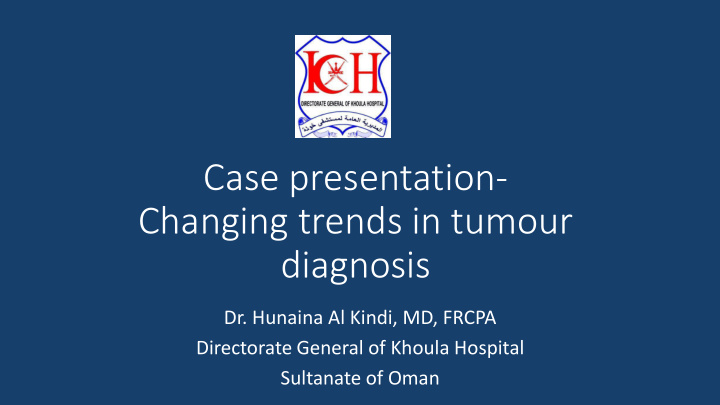



Case presentation- Changing trends in tumour diagnosis Dr. Hunaina Al Kindi, MD, FRCPA Directorate General of Khoula Hospital Sultanate of Oman
Clin linical l his history ry • A 5-year-old boy was operated for a right cerebellar lesion in 2015. • Reported as glioblastoma grade IV. • 3 years later (2018) presented with one month history of restlessness and headache at night. • Brain MRI revealed an enhancing mass lesion in the right cerebellum.
MRI Brain: 4.5 x 3.7 x 3.8 cm enhancing mass
What is the diagnosis?
Differential diagnosis • Anaplastic Ependymoma • Medulloblastoma • Glioblastoma with primitive neuronal component • CNS embryonal tumour, NOS • Embryonal tumour with multilayered rosettes • Atypical Teratoid/Rhabdoid tumour
EMA
Vim
CD99
Immunohistochemical profile Positive Negative • CD99 • GFAP • EMA focal, dot-like • SYNP • S100 • NSE • Vimentin • OLIG2 • Neurofilament: patchy • ATRX • NeuN: Focal • INI1 (nuclear retained)
What is the diagnosis?
Differential diagnosis • Anaplastic Ependymoma • Medulloblastoma • Glioblastoma with primitive neuronal component • CNS embryonal tumour, NOS • Embryonal tumour with multilayered rosettes • Atypical Teratoid/Rhabdoid tumour
Differential diagnosis • Anaplastic Ependymoma • Medulloblastoma • Glioblastoma with primitive neuronal component • CNS embryonal tumour, NOS • Embryonal tumour with multilayered rosettes • AT/RT
Differential diagnosis • CNS embryonal tumour, NOS • Embryonal tumour with • Synaptophysin multilayered rosettes • CD99 • NFP • Vimentin • -/+ GFAP • EMA • -/+NeuN: Focal
Differential diagnosis • CNS embryonal tumour, NOS • Embryonal tumour with • Synaptophysin multilayered rosettes • CD99 • NFP • Vimentin • -/+ GFAP • EMA • -/+NeuN: Focal
Molecular analysis • Internal tandem duplication within exon 15 of the BCOR gene. • Focal amplification of TERT gene • Splice site mutation in the SMARCA2 gene with loss of the remaining wild type allele
Diagnosis Central Nervous System High-grade Neuroepithelial Tumour with BCOR alteration
Dis Discussion • Central nervous system high-grade neuroepithelial tumour with BCOR alteration (CNS HGNET-BCOR) is a rare new entity • First described in February 2016 • Previously diagnosed as CNS primitive neuroectodermal tumours (CNS-PNET) as per the WHO classification (2000 & 2007) • CNS neuroblastoma • CNS ganglioneuroblastoma • Medulloepithelioma (ME) • Ependymoblastoma (EB) • Reclassified In WHO 2016 as CNS embryonal tumour, NOS
Disc iscussio ion • Recently molecular analysis of CNS- PNETs identified four new molecular entities designated as: • CNS neuroblastoma with FOXR2 (CNS NB-FOXR2) • CNS Ewing sarcoma family tumor with CIC alteration (CNS EFT-CIC ) • CNS high-grade neuroepithelial tumor with MN1 alteration (CNS HGNET-MN1) • CNS high-grade neuroepithelial tumor with BCOR alteration (CNS HGNET-BCOR)
Disc iscussio ion • Recently molecular analysis of CNS- PNETs identified four new molecular entities designated as: • CNS neuroblastoma with FOXR2 (CNS NB-FOXR2) • CNS Ewing sarcoma family tumor with CIC alteration (CNS EFT-CIC ) • CNS high-grade neuroepithelial tumor with MN1 alteration (CNS HGNET-MN1) • CNS high-grade neuroepithelial tumor with BCOR alteration (CNS HGNET-BCOR)
CNS HGNET-BCOR • Affects particularly children • Occurs mostly in the supratentorial but occasionally in the infratentorial region • Often resembles glioblastoma or anaplastic ependymoma • Absent or limited GFAP and Synaptophysin expression • Most tumor cells of CNS HGNET-BCOR exhibit • Glial morphology as stellate shaped cells with fibrillary processes • Ependymal-like perivascular pseudorosettes • Palisading necrosis
CNS HGNET-BCOR • Characterized by somatic internal tandem duplications (ITD) in the C-terminus (exon 15) of the BCL6 co-repressor (BCOR) gene and BCOR mRNA overexpression
BCOR in internal tan andem du duplic icatio ions • Recently described also in: • Clear cell sarcomas of the kidney • Subset of Soft tissue undifferentiated round cell sarcomas (URCS) in infants.
CNS HGNET-BCOR • Preliminary survival data suggests poor overall survival • May be overlooked and misdiagnosed as: • Anaplastic ependymomas • Glioblastomas • Medulloblastomas • CNS embryonal tumors, NOS
Con onclusion • CNS HGNET-BCOR is a new molecular entity. • Additional studies are needed to further characterize these rare new subtypes. • The non-specific CNS embryonal tumour, NOS category will be replaced by more specific entities.
Tak ake e ho home mess essage
Today - Brain tumour diagnosis is not by morphology alone but needs molecular & genetic signatures. - Molecular routes that lead to tumour development has modified treatment protocols as well.
Just as Artificial Intelligence and Robotics are poised to eliminate human jobs, I fear that ….
time is not far away when geneticists will at least partially replace us pathologists
Ack cknowledgment: Dr. Zahra Al Hajri Prof. Arie Perry
Thank you
Recommend
More recommend